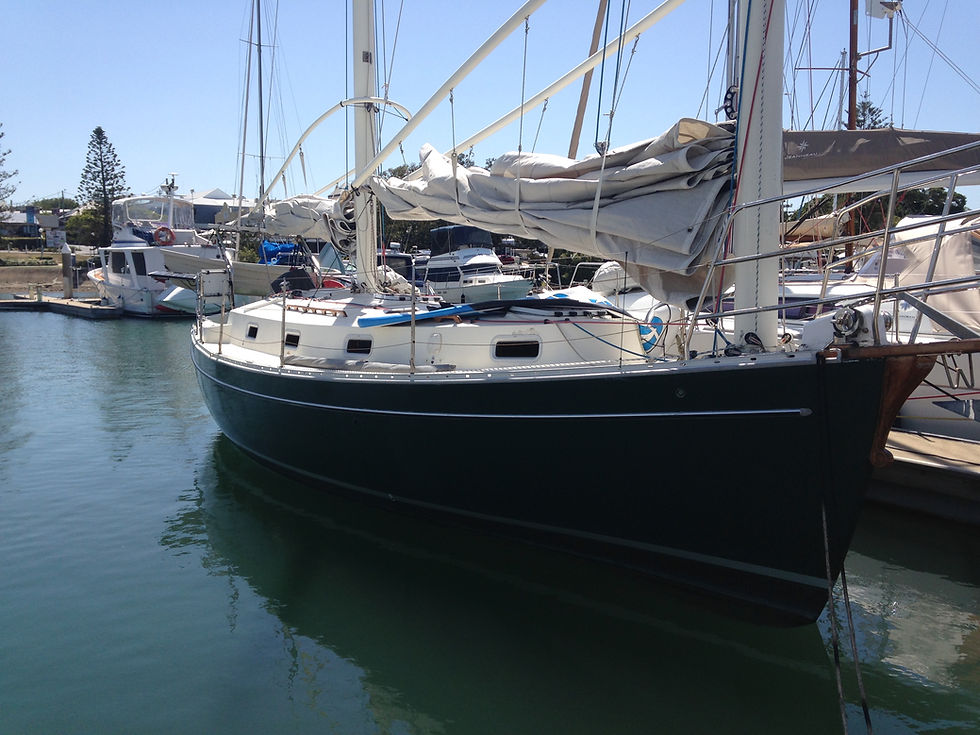OVERPROOF
- Mal Betts
- Jan 21, 2019
- 6 min read
Updated: Jun 3, 2023

Overproof is Mal’s own Crowther 8.9m which he built himself 30 years ago. Naturally she has an ICEER fridge and freezer! Overproof has been used as a test boat for Malcolm's products. She sails virtually every weekend in Moreton Bay and the refrigeration fitted in 2001 is still in perfect order.
Overproof's new BBElectric Drive is a huge success. She motors quietly and smoothly. Of particular note is the ease of berthing even in the hands of a novice crew member.
Overproof's tender has an EPropulsion electric outboard. Light, clean and easy to handle and more manoeuvrable than a traditional outboard, the crew is looking forward improved success in wildlife spotting from it.
Now that there are so many advantages to the electric drives, being "green" is way down the list; Malcolm was however pleased that a recent weekend trip to Moreton Island was carbon free.
Electric Drive Conversion by Malcolm
Overproof was built in 1986 and launched in 1987. Up until 2016 her auxiliary power was from a single, centre mounted 10 hp raw, water-cooled diesel via a long tail drive system. The diesel had given good service but after 29 years internal rust caught up with it; even after a rebuild it was not reliable any more. Many parts were just holding on and threatened to be expensive replacements.
I had being researching electric options for some years and recent advances in motor and battery technology made an electric drive a viable option. I was not prepared to compromise on boating pleasure so my goal was to have a system with the same power and thrust as my old diesel, using my existing drive shaft and propeller (330mm diameter and 200mm pitch).
Batteries
I had been using a small bank of lithium batteries (1.4kw @ 12vdc) to power the boat's electrical system for some years. To power the electrical propulsion motor successfully a larger and higher voltage bank was needed. Combining my battery bank with new units and reconfiguring the voltage to a 6.7kw @ 48vdc battery I assessed would be adequate for my needs.
Practicalities
As we normally race every weekend, it was important to keep the boat operational as long as possible before removing the engine. The first step was to build the battery locker. Overproof is not a large cat at 8.9 m with tube hulls and no bridge deck. Keeping the 48Vdc 6.7kw battery bank and electrics dry was prime objective. To achieve this I had to create a new locker in the port side of the main beam which would be accessible from inside the cabin and have minimal cable run to the electric motor. To effect this, the port in-beam sail locker was portioned off to make the new battery / switchboard locker. Several days of awkward cutting and glassing ensued to achieve this goal. There were the usual exasperating marine problems of trying to mount square items into a small, unaccommodating space which is anything but square!
Electric Motor
After many calculations and assessments and much internet research, I decided to use a 5kW water cooled BLDC motor with a sine wave controller. A composite fibreglass/carbon mounting box was crafted to house this reusing the original engine mount bases for minimal changes to motor bay.
The Changeover
The old engine was removed and engine bay cleaned as best as possible . Unfortunately after many years of use grease and oil stains are heavily embedded into the paintwork. I did not have time for a re-paint (gotta race!) so a darn good scrub was all I could do. The new motor fitted in well and after some shaft alignment work, all was good to finish the electrical wiring.
Weight
As I have mentioned, weekly racing is important to me and this makes me very conscious of weight on the boat. I weighed all the accessory parts that I removed and was surprised that the overall weight, including 20L fuel, added up to 50kg. Removing the parts also reminded me that replacing these things would cost money to buy and fit over and above the expense of a new diesel purchase. The engine itself weighed 100kg bringing the total weight removed to 150kg. With the new lithium batteries and equipment for the electric motor mounts, it is still 40kg lighter than the diesel. Also, I have been able to move the weight further forward, improving the trim of the boat.
Finishing touches
It always takes longer to do jobs on the water than you think, with so many "5 min jobs" which take considerably more than 5 minutes. A great deal of thought went into making the operation of the new drive as simple as possible leading me to dispense with the traditional gear leaver and its cables. Instead a throttle was crafted with forward and reversing selector switch on the tiller bar. This has been a great success especially for berthing as the helmsman no longer has to bend down to change gear taking his eyes off the situation; simplified, much more accurate berthing is possible even by novices. The battery locker was relined with the same carpet in the boat for a co-ordinated interior. Fortunately I had the good sense to keep my off cuts from 30 years ago!
Performance
To measure my power consumption I am using a Victron amp hour meter on my dash and via an app I can see the information on my phone. This makes it very easy to see the history of my solar charging and battery state.
The boat achieves 7 knots at full power (6000 watts) which is the same speed that the diesel achieved. At a cruising speed of 5 knots motor the power draw is 1850 watts.
On a normal race day, to get out of Newport harbour and to the start line, then back to the berth after racing battery consumption averages out about 1.25 kWh's. I have not used a mains charger yet. With only 160 watts of solar panels, the power used from a race is replenished in just over two days ensuring my boat is fully charged for the next weekend's sailing fun. No buying fuel, adding anti mould stuff or checking oil for me now!
Weekend cruising has been successful too. On a recent trip to Moreton Island running my ICEER fridge, navigation, autopilot, etc and drive system we anchored at Moreton (16 nm trip) having used 1.25 kWh's.
Next day, 24hrs on the 320 watts of solar panels had fully charged the batteries.
The power consumption of the electric motor matches the propeller load and it is interesting when motor sailing to see just how little power you need with the slightest of breeze but still maintain a good cruising speed. This advantage makes long passages on low wind days a reality,
Costs
At the end of the day it all comes down to money. Because the costs of small horse power diesels are high, converting to electric for the typical lower hp yacht auxiliary works out surprisingly well . Summary list of my materials spend as follows:-
Motor and controller
48 - 12V dc-dc reducers
Extra batteries
BMS (Battery management system)
Solar panels
Mechanical items: thrust bearings, lay shaft and reduction drives.
Associated electrical systems
Fibreglass costs
Total Under $9800
This would be different for other yachts depending on individual needs, but it was a pleasant surprise to me to achieve this including the solar charging. As yet I have not plugged in to shore power mains.
Summary
It would have been an easier decision just to put in another diesel with a known outcome but the more I got into the electric build, it became increasingly obvious that it was so much better on so many levels:
Ease of working on: fewer parts, lighter parts. My heaviest lift is 12kg as opposed to 100kg diesel engine.
Cleaner: no greasy diesel and oil.
Maintenance: Spares are less in number and cost. In fact you could keep a spare motor and controller, they are "plug-in and play". Most of the cost is in the batteries and management, which are durable and virtually maintenance free. There are no oil & filter changes to do which is a huge saving in time and expense.
Berthing The electric motor makes this a breeze; the control over propeller speed is vastly superior.
Lower engine noise because Overproof's engine is in the middle and not in the hull noise was more pronounced. The electric motor has reduced this significantly, Click video below
Things I don't miss:
Gearbox and engine oil changes
Fuel fetching, filling and adding additive to prevent spoiling.
Replacing the water impeller, fuel filters and engine belts.
Service costs
Noise & smell.
I have been very happy with the outcome on Overproof. I look forward to applying my electrical knowledge and experience to make it easier for you to make the change - you won't regret it.
Give me a call 0419674135






































Comments